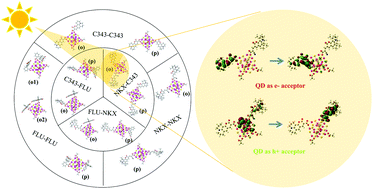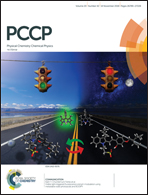Quantum dots as an electron or hole acceptor: on some factors affecting charge transfer in dye–quantum dot composites†
Abstract
We report a density functional theory (DFT)/time dependent DFT (TDDFT) computational investigation on some factors affecting the nature of charge transfer in CdS quantum dots (QDs) of two different sizes attached to one or two units of dyes among three species viz., coumarine (C343), fluorescein (FLU) and NKX-2388 (NKX). The direction and nature of charge transfers have been ascertained from natural transition orbital analysis. Factors affecting the charge transfer mechanism include the interaction of dyes with QDs, the interaction of a dye with another dye and the effect of solvation. The strength of interaction of the dye and QD depends on the orientation of the dye unit(s) and the type of anchoring group of the dyes and even the direction of charge transfer reverses for different orientation of the dye with respect to the QD in some systems. In addition, hybridized energy levels of the dye–QD composites are formed which leads to direct charge transfer. We observe both direct and indirect charge transfers for different excited states, which is indeed an interesting feature. Interestingly, when two dye molecules are attached to a QD, the direct charge transfer exists between dyes of the same species only. The energy levels, as well as corresponding absorption peaks, exhibit pronounced energy shifts in implicit solvation models.



 Please wait while we load your content...
Please wait while we load your content...